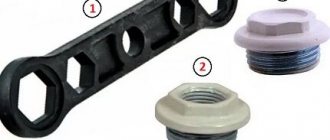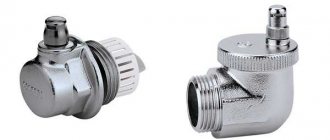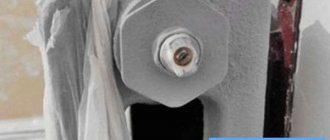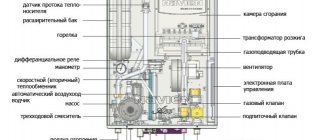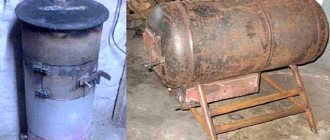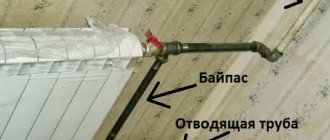Dissolved air enters the heating system along with the coolant. Accumulating in significant quantities, oxygen creates plugs that prevent normal fluid circulation. This reduces the quality of heating of the building. To eliminate airing of the system, a Mayevsky crane was designed. The principle of operation is simple and clear, so such a device is installed everywhere - be it a multi-storey building or a modest cottage.
The Mayevsky crane helps get rid of air jams in the heating network
Purpose of the Mayevsky crane
Air is lighter than water, so it accumulates at the peak points of the space heating system and radiators. This happens for several reasons:
- pipes do not fill with water quickly enough;
- the fed system was partially empty;
- There is a lot of dissolved oxygen in water.
Sometimes the accumulation of air provokes a special design of the heating system, when in certain areas loops of pipes are formed, turned upward.
In 1931, the State Planning Committee decided that during downstream installations, ordinary taps should be installed to remove air from systems. But through them, residents of houses not only eliminated air locks, but often drained hot water, which in this case acts as a coolant, and then used it for household needs - for example, to wash the floors. This was unacceptable from the standpoint of sanitation and the technology of central heating of buildings. Therefore, Mayevsky taps began to be installed on radiators, which significantly complicated the task of inappropriate use of coolant.
Installing a tap prevents water from being used for other purposes
Auto
The Mayevsky tap itself cannot automatically remove air; it is a device exclusively for manual removal of gases. However, using the same principle, automatic air vents are developed and produced, whose operating principle is similar to the Mayevsky crane, and they do most of the work independently.
Automatic air vent RVC
An automatic air valve has a small chamber oriented strictly vertically to collect air. Inside the chamber there is a float connected by a rigid connection to a needle valve located at the top of the device. As soon as the level of the air layer exceeds the permissible limit, the valve opens briefly and the air is released. Since the float also rises, the valve quickly returns to its seat and prevents coolant from leaking out.
Automatic gas outlet is a mandatory element in an autonomous closed heating system. During the inevitable process of corrosion, the release of air bubbles from water, or during the reaction of aluminum with water, if there is direct contact between them, gas pockets accumulate that can block the path of the coolant or cause the permissible pressure to be exceeded. Air exhaust solves these problems without the participation of residents.
How the Mayevsky crane works
The device was developed in 1933 by an engineer from Leningrad, Cheslav Bronislavovich Mayevsky. Officially it is called a radiator needle air valve.
According to some historical data, the crane of Minsk resident S.A. Roev first appeared. It consisted of two parts separated by a gasket. The devices were tested in 1932. A year later, Mayevsky improved this design, improving the sealing of parts. In a more modern interpretation, the engineer connected the parts using the “cone-to-cone” method.
The crane consists of the following components:
- frame;
- conical head screw;
- turning part;
- inlet and outlet channels for air.
Design of the device
The air vent device drives the locking screw. The latter is controlled with a screwdriver or manually, which depends on the specific model. In the modern version, a special key is already installed on the tap, so using the device has become easier.
Advantages of installing a Mayevsky crane:
- increasing the efficiency of the heating network;
- simplification of radiator maintenance;
- affordable cost of the unit itself.
But such a crane, despite the listed advantages, also has a drawback. Since the quality of the coolant often leaves much to be desired, blockages often occur in the tap during operation.
Depending on the design, there are three types of crane:
- radiator - intended for heating devices;
- traditional - installed everywhere, equipped with external thread;
- complete - is a ball valve with KM.
Sectional drawing of a faucet
Depending on the method of unscrewing, there are the following devices:
- for a screwdriver;
- turnkey four- or hexagonal;
- with a handle, which does not require a tool.
Various materials and their combinations are also used for manufacturing. There are CMs:
- steel;
- brass;
- cast iron;
- stainless steel;
- plastic.
Most often, the assembly is made from brass, which is resistant to corrosion, which threatens the materials due to unfavorable operating conditions. Often, unscrupulous sellers pass off cheap silumian as brass. But this material is unreliable, products made from it quickly fail.
Attention! Children love to play with various objects. Therefore, it is better to install a tap in their room that can be opened with a screwdriver. If the baby opens the tap on his own, he will get burns.
In children's rooms, it is recommended to install device models “under a screwdriver”
Automatic KM
Automatic CMs are convenient in private homes with individual heating, as they eliminate air locks and regulate the pressure independently. Inside this unit there is a chamber equipped with a float inside. This, in turn, is connected to a needle valve located at the top of the assembly.
When the air gap exceeds the set limit, the valve opens for a while, allowing air to leave the system. Then, due to the action of the float, it returns to its original position again, preventing water from flowing out.
Automatic crane model
The main advantage of AKM is that there is no need to place a container to remove air trapped inside the pipes, since water does not flow out. The tap is automatically blocked as soon as the coolant level rises. However, automatic models are more expensive than mechanical ones.
Air vents are:
- straight;
- corner;
- radiator.
Video - Mayevsky crane: what it is and how it works
Types of automatic air vents
Automatic air vents are made in several types: straight, angular and radiator.
Direct automatic air vent and shut-off valve
First, screw in the shut-off valve. It will cut off water in the system if the air vent needs to be changed or if it fails. The picture shows a plastic flag on which the air vent presses when screwed in. The flag presses the check valve spring, thereby connecting the automatic air vent to the heating system.
A ball valve is often used instead of a shut-off valve. It is more reliable because there are no plastic parts and no check valve, which may not work in dirty water.
The angular automatic air vent has the same design as the straight one, with the difference that its connecting nipple is at an angle of 90 degrees to the vertical. It is installed in the heating radiator plug.
The radiator air vent is screwed into the heating battery instead of a plug.
Radiator air vent
All air vents are installed with the cap facing up, since the float only works in a vertical position.
There are productions where automatic Mayevsky cranes are needed. Where you have to release air at high altitudes, in inconvenient places. For example, on high risers. Above various boilers: heating, boilers.
Prices for Mayevsky cranes are low. Mechanical ones are inexpensive. From 24 rubles. Automatic ones are a little more expensive: from two hundred rubles.
Where to install the device?
The device is installed at the highest points of the premises network. However, in addition, the installation diagram of the heating network is taken into account.
The vertical method of supplying coolant requires that each radiator located on the top floor, where there is a lower supply with a return line, be equipped with a KM.
Air valves are also needed everywhere on devices in which the supply line is completely or partially below the level of the upper connection axis. Then the natural elimination of the oxygen plug becomes more difficult. In the horizontal version of the circuit, the CM is placed on each heating radiator.
Placement of Mayevsky air vent valves for both scheme options
Air valves are also installed in areas where there are bends in the pipeline. So, for example, when a pipe bends sharply upward and then descends down a short section, a pocket is formed. Airing will constantly occur in this area. The crane is installed here at the top point of the site.
The “warm floor” system in most cases also requires the installation of this equipment. Air release is most effective on the collector group, which rises above the floor level.
“Heated floor” systems are rapidly gaining popularity among owners of private country houses and city apartments. In a special article we will tell you whether it is possible to connect a “warm floor” from heating.
Mayevsky taps are also installed in the towel dryer in the bathroom. This is necessary when airing occurs regularly in the system. The manufacturer provides a hole for the valve in heated towel rails connected from below. When connecting laterally, this section of the pipe is slightly modified. Then a tee with the required thread parameters is implanted into the supply zone. Install the device, directing the outlet away from the wall.
It is important! If air constantly accumulates in the pipes, then during the next repair it is worth purchasing models of towels that are already equipped with a Mayevsky tap.
Towels with installed air vent
Frequent errors and problems during installation
It is necessary to unscrew the screw one to one and a half turns. This is quite enough. If you unscrew the screw too much, it will be difficult to screw it back in under pressure, and quite a bit of water will spill out.
It is advisable to mount the valve in such a position that the hole is directed away from the wall and downwards - the wall will not be splashed when water is released.
When replacing the air vent, when unscrewing it, you must hold the plug with a second adjustable wrench, otherwise it will be unscrewed from the battery.
What to look for when buying an air vent valve?
Heating systems are susceptible to water hammer. This happens rarely, but the possibility exists. Therefore, it is better to choose models with a safety valve that is sensitive to pressure changes. When the indicator reaches critical levels, the valve opens and water leaves the heating circuit.
Reference. Water hammer is a pressure difference that is caused by a sharp change in the speed of the coolant. This phenomenon leads to the formation of cracks, ruptures of pipes and radiators, as a result of which the coolant flows out of the system and floods the premises. PVC pipes are most often damaged.
It is better to choose products with rubber or silicone gaskets. There are also paronite gaskets, but they have proven to be worse. Additionally, the thread can be strengthened with linen tow or fum tape.
Water hammer in the heating system
When choosing a faucet, take into account its location and the design of the heating system itself.
Manual models of cranes are universal. When purchasing them, you must take into account the distance from the pipe on which the valve is installed to the wall. The distance is left such that the tool can be used, especially if this requires a screwdriver or pliers.
Automatic machines are not very suitable for centralized heating systems. There, the purity of the coolant raises questions, so the unit often gets clogged. Such models are not very suitable for cast iron radiators either. In the latter case, manual models in a brass case have proven themselves better. They can also be used in steam heating systems.
But AKMs are convenient in tight spaces and places with difficult access. They are also used in underfloor heating systems, since it is difficult to detect the formation of an air lock.
The Mayevsky tap will not interfere with the “warm floor” water system
When purchasing, pay attention to the thread parameters. You should also find out the type of socket on the radiator. For sale, manufacturers offer KM models equipped with a handle with a side outlet, which are more convenient than those located in the traditional way.
Also, when choosing a node, take into account the following characteristics:
- permissible pressure;
- working temperature.
Technical characteristics of the air vent
The required functional properties are presented in the following table:
| Technical specifications | Permissible value | Units |
| Pressure (working) | 10 | ATI |
| Temperature (maximum) | 120 | ºС |
| Passage diameter | 25.4 or 20.0 | mm |
| Thread diameter | 25.4 or 20.0 | mm |
| Working environment | water and other non-aggressive liquids | — |
| Life time | 20 — 25 | years |
| Leakage class | "A" | — |
During operation, malfunctions in the operation of the devices cannot be ruled out. A frequent reason for the loss of performance of Mayevsky cranes is small debris moved by the coolant.
If the faucet becomes clogged and no longer works, it is recommended to carry out simple maintenance:
- Isolate the radiator from the system with shut-off valves.
- Release approximately 1/3 of the water volume from the battery.
- Remove the device from the battery case.
- Clean the passage hole with a thin (non-metallic) sharp object.
Heating systems are not always equipped with radiators that have plugs with ready-made holes for Mayevsky taps. In such cases, the terminals for the air vents will have to be made by hand. No particular difficulties are foreseen in this matter. You just need to drill a hole for the installation size of the faucet and cut the thread.
The installation of taps in the housing of cast iron heating radiators should be given special attention. Products made from high-quality, reliable materials are traditionally used here.
The hole is drilled with a metal drill using a drill, and the thread is cut with a tap. Of course, the diameter of the drill is chosen 1 - 1.5 mm less than the installation size of the faucet, and the tap is exactly the size.
Step-by-step instructions for installing KM into the system
At the first stage, preparatory work is carried out. It is advisable to carry out the installation in the warm season, when it is possible to remove coolant from the heating system. Often in old radiators there is no special hole for the CM, so it must be drilled.
- At the first stage, the pipes are removed.
- Remove the radiator from the hooks and completely drain the water.
- On the side opposite from the pipe entrance, a hole is drilled in the top plug, the diameter of which corresponds to the purchased CM.
- The threads are cut inside according to the one used on the KM. It should be taken into account that the tap has a right-hand thread, therefore, the plug has a left-hand thread. Another option is to replace the entire plug at once.
- Then install the tap, as indicated in the instructions for the device.
- The battery is returned to its place.
- At the last stage, the pipeline is connected.
For cast iron batteries, factories produce ready-made plugs for air vent valves.
The outlet hole of the valve is directed slightly downward. This makes it easier to collect the water that should flow from the tap.
When installing the device on heating pipes made of plastic, a fitting will be required.
Attention! Valves with manual control are usually installed horizontally, automatic valves are installed vertically. The correct installation must be clarified in the instructions.
Signs of system blockage
Video - Equipping a heated towel rail with an air vent tap
Conclusions and useful video on the topic
The video demonstrates the principle of operation of the Mayevsky crane and provides recommendations for its installation:
Simple in design and easy to maintain, air vents are also an integral technical part of any heating system. Deliberate exclusion of devices from the system threatens to result in serious consequences, including defrosting of batteries and pipes in winter. It is impossible to ignore Mayevsky’s taps; they just need to be selected for a specific system.
Please write comments in the block below. Tell us about your own experience in installing mechanical air vents. Ask questions, share your opinion and photographs on the topic.
How to bleed air from a heating system?
If the coolant is driven by the circulation pump, it is turned off. At least 15 minutes must pass between stopping the equipment and starting to bleed air. During this time, oxygen will rise up.
Prepare a container that will be needed to collect water. Using a screwdriver, wrench or turning the handle, unscrew the tap until a characteristic hissing sound is heard - a sign that air is leaving the system. However, simply waiting for the hissing to stop is not enough. The water needs to flow. This means that the traffic jam has been removed. The stream should be smooth and flow without interruptions. Only after this the valve is closed.
Attention! Sometimes, even after repeated bleeding, air pockets still form. Then the cause may be a breakdown or insufficient twisting.
If the stream of water is uniform, without interruptions, then the air has been removed
Alternative replacement options
Hydrant
- If the owner for some reason does not want to install a Mayevsky crane, the following procedure can be performed. Loosen the thread on the top pipe coming out of the radiator. So, the air will come out, and at the same time it will splash everything around.
- In the case when the system does not involve the use of a pump, this means that the water flow rate is low. In this case, natural oxygen removal can be organized. So, a vertical outlet with an empty expansion tank at the end is cut into the upper part of the battery in the area of the pipe.
- When using an ion boiler with a closed water circulation system, the Mayevsky tap will not last long. The fact is that a brine solution is added to the coolant to further accelerate the ions in the boiler. When bleeding air, salts will be deposited inside the valve, which will lead to rapid failure. For ion boilers, special devices are provided that are resistant to salts.
Flood in the house
Features of crane operation
If the device is used correctly, the entire heating system will work correctly, and undesirable consequences will be minimized.
The taps last a long time. The problematic side of operation is that they often become clogged. Then the equipment is cleaned. Use a needle for this.
The problem area can be detected independently at home without the involvement of a specialist. The method is quite simple, and you only need a piece of paper. The valve is left open to allow air to escape. Take a sheet of paper in your hands and pass it at a distance of 1 cm over all places where there are connections and along pipes and radiators. In an area where there is no seal, the paper will stick.
WD-40 will help open a faucet that has not been used for a long time
This area is carefully inspected and the cause of the air leak is determined. Then the system is serviced and the failed element is replaced.
It happens that the air vents have not been used for a long time. Then the tap thread may oxidize, making it impossible to remove air from the heating pipes. To get rid of rust, use WD-40 or similar products. Then lightly tap the surface and try to open the valve.
Advice for business
Before deciding to purchase air exhaust devices, it is recommended to carefully study the arrangement of devices in the heating circuit.
Small-sized special keys are convenient to use in cramped conditions, where the use of a screwdriver is hampered by nearby other objects
Depending on the degree of freedom of access to the equipment, Mayevsky cranes of a suitable modification should be installed.
Where it is difficult to work with a screwdriver, turnkey models are better suited, and where it is difficult to work with keys, it is wise to place automatic devices. Careful analysis will help make device maintenance more efficient and save on purchases.
Automatic air vents are traditionally installed on pipeline lines, at points of potential accumulation of air masses. Such devices, as a rule, are not used on radiators.
Manual devices have the most simplified design, for example, compared to automatic air vents. But, as practice shows, simplicity is the key to reliability.
If cast iron radiators are used in the heating system, manual taps are more reliable for such a system than automatic ones. Meanwhile, the degree of reliability of the design largely depends on the quality of the metal (brass) from which the air vent is made.
Mayevsky tap assembled with a nylon plug. Design specially prepared for installation in a system built on polypropylene pipes
You can also mention the experience of introducing Mayevsky taps into heating circuits built on plastic pipes. This material quite reliably maintains stable pressure and temperature, but is weak against water hammer.
Installing a Mayevsky crane paired with a safety valve or a full-fledged safety group increases the reliability of the system for such cases. In general, for circuits where pressure stability is in question, it is recommended to use taps as stabilizers.
Why do radiators get airy and what does this lead to?
The reasons for the appearance of air jams can be different:
- Incorrectly selected slope when installing elements of a gravity system. If the slope is insufficient or absent, circulation will be weak and air pockets will appear.
- Incorrect installation of forced circulation systems.
- Low pressure level in pipes. In their clearance there will be voids filled with air.
- Using the wrong coolant. The liquid poured into the radiator reacts with the metal from which it is made. As a result, oxygen or hydrogen is formed. They create gas-air plugs.
- Coolant overheating. Most often occurs in old single-pipe systems. Due to the high pressure, the boiling point of water in them is lowered, but if the pressure decreases, the carrier will boil, releasing gases. They form an air jam.
- Too active filling of empty communications. The coolant, entering the pipes at high speed, bubbles, and then the bubbles turn into a plug.
- Weak sealing. Air can leak inside thermal communications even through microscopic holes. Therefore, a small gap or leaking fittings can cause such a problem.
Gas-air plugs are detrimental to thermal communications. The batteries heat up poorly and unevenly, and the pipes can make a hum. But the most unpleasant thing is that gaseous substances, when reacting with metal, oxidize and destroy thermal elements. We have to do repairs and restoration. Therefore, it is necessary to get rid of gas-air sources. It is imperative to find the cause of the airing and eliminate it. Bleeding the air is a temporary solution to the problem.
The lineup
On the plumbing market today there is a wide variety of Mayevsky taps from various manufacturers located both in Russia and abroad using various components and materials. Metal or plastic keys for these devices are sold separately.
Prices for valves range from 21-51 rubles. the material of manufacture is chrome steel (at these prices you can buy taps from, Kazan) up to 475 rubles. — Mayevsky manual faucet made of chrome-plated brass, Barnaul. Also on the market are tees with a Mayevsky tap (cost about 600 rubles), keys (cost ranges from 20-120 rubles). An automatic Mayevsky faucet costs about 250-700 rubles, while a full bore faucet for cast iron radiators costs more.
